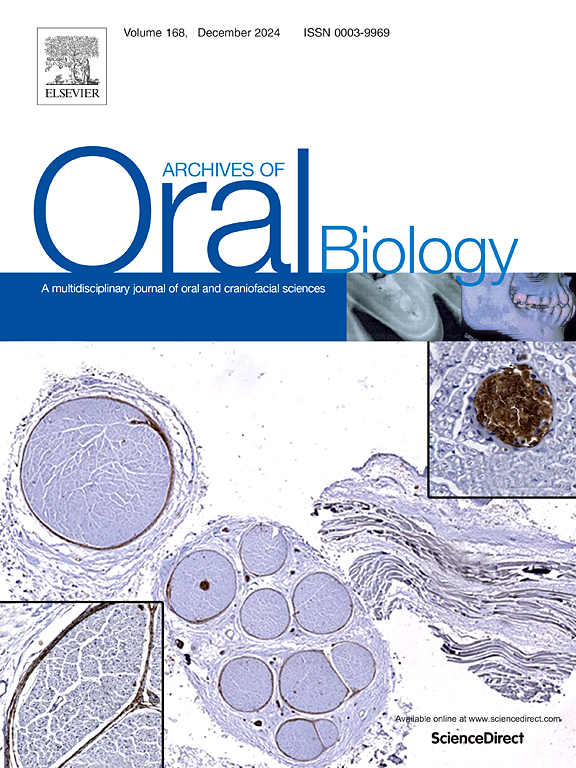Next-generation sequencing analysis of bacterial species present in the sequestrum of medication-related osteonecrosis of the jaw patients
IF 2.2
4区 医学
Q2 DENTISTRY, ORAL SURGERY & MEDICINE
引用次数: 0
Abstract
Objective
Antiresorptives cases of adverse reactions to highly effective drugs used to treat skeletal-related events that occur during treatment of osteoporosis or malignancy have been reported in the jaw. To date, there is no clear pathophysiology for medication-related osteonecrosis of the jaw (MRONJ), but the role of inflammation or infection has been proposed as one of several possible pathogenesis theories. This study was designed to investigate the role of infection in the pathogenesis of MRONJ by analyzing the microbial communities observed in the bone samples from MRONJ patients.
Design
Oral microbial samples were collected from 39 MRONJ patients and 45 healthy patients and subjected to next generation sequencing analysis. Alpha diversity, beta diversity, linear discriminant analysis and effect size, and network analysis were applied to compare the microbiome features.
Results
The 10 predominant microbial strains observed in MRONJ patients were Streptococcus spp. S. constellatus, Tannerella forsythia, Parvimonas micra, Granulicatella adiacens, Bacteroidaceae G-1 bacterium HMT 272, Treponema socranskii, T. maltophilum, Pyramidobacter piscolens, and Fretibacterium fastidiosum. Network analysis revealed a significant correlation between T. forsythia and P. gingivalis. T. socranskii was closely related to T. maltophilum, Fretibacterium fastidiosum, and Peptostreptococcaceae nodatum. G. adiacens was closely related to Streptococcus parasanguinis, S. sanguinis, and Prevotella buccae.
Conclusions
In conclusion, this study sheds light on the potential role of infection in the pathogenesis of MRONJ. A distinct microbial profile was identified in MRONJ patients, with notable predominance of S. constellatus, T. forsythia, P. micra and G. adiacens among others. Network analysis further revealed significant correlations between certain microbial strains, suggesting possible synergistic interactions in MRONJ pathogenesis. These findings contribute to a deeper understanding of the complex microbial dynamics underlying MRONJ and may inform future therapeutic strategies aimed at targeting specific bacterial species implicated in this condition.
颌骨药物相关性骨坏死患者遗骨中细菌种类的新一代测序分析。
目的:在治疗骨质疏松症或恶性肿瘤期间,对用于治疗骨骼相关事件的高效药物进行抗吸收治疗的不良反应病例已被报道。迄今为止,药物相关性颌骨骨坏死(MRONJ)的病理生理机制尚不明确,但炎症或感染的作用已被提出为几种可能的发病理论之一。本研究旨在通过分析MRONJ患者骨样本中观察到的微生物群落,探讨感染在MRONJ发病机制中的作用。设计:收集39例MRONJ患者和45例健康患者的口腔微生物样本,进行下一代测序分析。采用α多样性、β多样性、线性判别分析和效应大小、网络分析对微生物组特征进行比较。结果:MRONJ患者中观察到的优势菌群为:星形链球菌、连翘单宁菌、微细小单胞菌、棘粒菌、拟杆菌科G-1细菌HMT 272、索氏密螺旋体、嗜麦芽单胞菌、piscol锥体杆菌和嗜腐微杆菌。网络分析结果表明,连翘与牙龈草具有显著的相关性。socranskii与嗜麦芽链球菌(T. maltophilum)、苛食微杆菌(Fretibacterium fastidiosum)和胃链球菌科(Peptostreptococcaceae nodatum)亲缘关系密切。G. adiacens与副血链球菌、血链球菌和布氏普雷沃氏菌有密切的亲缘关系。结论:本研究揭示了感染在MRONJ发病机制中的潜在作用。在MRONJ患者中发现了不同的微生物谱,其中以星形菌、连翘菌、微孢子菌和棘齿菌为主。网络分析进一步揭示了某些微生物菌株之间的显著相关性,提示在MRONJ发病机制中可能存在协同作用。这些发现有助于更深入地了解MRONJ背后复杂的微生物动力学,并可能为未来针对与该疾病有关的特定细菌物种的治疗策略提供信息。
本文章由计算机程序翻译,如有差异,请以英文原文为准。
求助全文
约1分钟内获得全文
求助全文
来源期刊

Archives of oral biology
医学-牙科与口腔外科
CiteScore
5.10
自引率
3.30%
发文量
177
审稿时长
26 days
期刊介绍:
Archives of Oral Biology is an international journal which aims to publish papers of the highest scientific quality in the oral and craniofacial sciences. The journal is particularly interested in research which advances knowledge in the mechanisms of craniofacial development and disease, including:
Cell and molecular biology
Molecular genetics
Immunology
Pathogenesis
Cellular microbiology
Embryology
Syndromology
Forensic dentistry
 求助内容:
求助内容: 应助结果提醒方式:
应助结果提醒方式:


